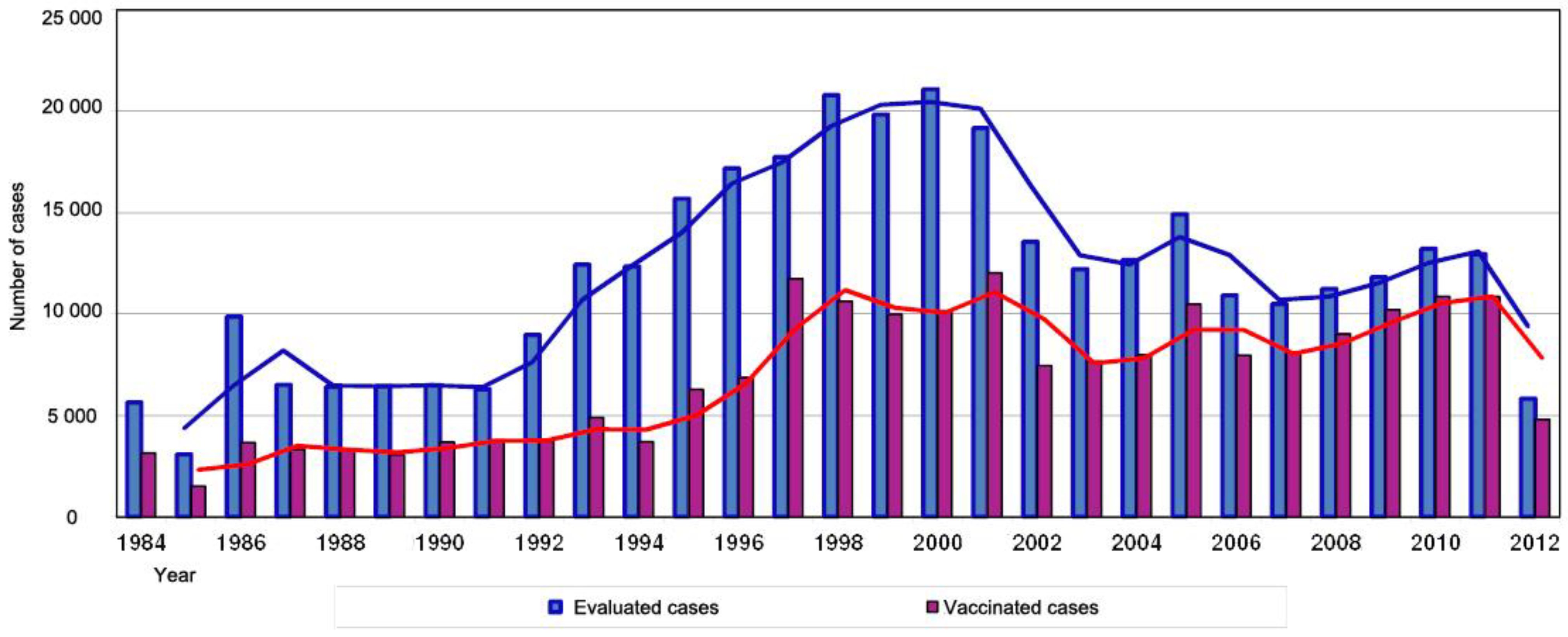Epidemiological Management of Rabies in Romania
Abstract
Introduction
Methods
Results
Discussion
Conclusion
Author Contributions
Conflicts of Interest
References
- Liu, X.; Feng, X.; Tang, Q.; Wang, Z.; Qiu, Z.; Li, Y.; et al. Characterization and potential diagnostic application of monoclonal antibodies specific to rabies virus. J Biomed Res. 2010, 24, 395–403. [Google Scholar] [CrossRef] [PubMed]
- ECDC. European Center for Disease Prevention and Control (ECDC). Rabies. 2012. Available online: http://ecdc.europa.eu/en/health topics/rabies/Pages/index.aspx (accessed on 19 July 2012).
- Feder, H.M., Jr.; Petersen, B.W.; Robertson, K.L.; Rupprecht, C.E. Rabies: still a uniformly fatal disease? Historical occurrence, epidemiological trends, and paradigm shifts. Curr Infect Dis Rep. 2012, 14, 408–22. [Google Scholar] [CrossRef] [PubMed]
- National Institute for Infectious Diseases "Prof.Dr. Matei Balş", Romania. Antirabic Center. 2012. Available online: http://www.mateibals.ro (accessed on 20 August 2012).
- ROMANIA, HOTARÂRE, pentru aprobarea Programului strategic pentru supravegherea, controlul şi eradicarea rabiei la vulpe în România, Ordonanţa Guvernului nr. 42/2004, complătari prin Legea nr. 215/2004.
- Muller, T.; Batza, H.J.; Freuling, C.; Kliemt, A.; Kliemt, J.; Heuser, R.; et al. Elimination of terrestrial rabies in Germany using oral vaccination of foxes. Berl Munch Tierarztl Wochenschr. 2012, 125, 178–90. [Google Scholar] [PubMed]
- ANSVSA. Notă de fundamentare. Hotărâre privind modificarea şi completarea Hotărârii Guvernului nr. 55/2008 pentru aprobarea Programului strategic privind supravegherea, controlul şi eradicarea turbării la vulpe în România. 2008. Available online: http://www.ansvsa.ro/documente/ admin/Proiect%20HG%20modificare%20si%20compl etare%20HG%20nr.%2055%20din%202008%20Prog ram%20Strategic%20rabie_29149ro.pdf (accessed on 10 August 2012).
- Hotărârea Guvernului, nr. 55/2008 pentru aprobarea Programului strategic privind supravegherea, controlul şi eradicarea turbării la vulpe în România.
- Number of presentations to the National Institute for Infectious Diseases "Prof.Dr. Matei Balş", the Antirabic Center between 1984-2012. 2012. Available online: http://www.mateibals.ro/html/ docBals/antirabic/s5.pdf (accessed on 20 August 2012).
- WHO. Rabies. 2012. Available online: http://www.who.int/rabies/en/ (accessed on 19 July 2012).
- Mehndiratta, S. Animal bites in children: burden in urban Delhi. Trop Doct. 2012, 42, 114–5. [Google Scholar] [CrossRef] [PubMed]
- Nesterov, V.; Ciofan, I.; Cristescu, P.; et al. Cercetări privind depistarea cazurilor de turbare la carnasierele sălbatice. Analele ICAS. 1973, 29, 87–110. [Google Scholar]
- Vier Pfoten. Fii om cu animalele. Stuaţia câinilor fără stăpân şi soluţia Vier Pfoten România. Available online: http://www.vier-pfoten. ro/website/uploads/Situatia_cainilorcomunitariinRom ania.pdf (accessed on 15 August 2012).
- WHO. Information Surveillance Report. Rabies- Bulletin-Europe 2011, 35. [Google Scholar]
- Picard-Meyer, E.; Robardet, E.; Moroz, D.; Trotsenko, Z.; Drozhzhe, Z.; Biarnais, M.; et al. Molecular epidemiology of rabies in Ukraine. Arch Virol. 2012. [CrossRef] [PubMed]
- Racey, P.A.; Hutson, A.M.; Lina, P.H. Bat Rabies, Public Health and European Bat Conservation. Zoonoses Public Health. 2012. [CrossRef] [PubMed]
- Hellenbrand, W.; Meyer, C.; Rasch, G.; Steffens, I. Ammon Cases of rabies in Germany following organ transplantation. Euro Surveill. 2005, 10, E050224–6. [Google Scholar]
- Rimhanen-Finne, R.; Jarvinen, A.; Kuusi, M.; Quiambao, B.P.; Malbas, F.F., Jr.; Huovilainen, A.; et al. Imported human rabies, the Philippines and Finland, 2007. Emerg Infect Dis. 2010, 16, 1318–9. [Google Scholar] [CrossRef] [PubMed]
- Schmiedel, S.; Panning, M.; Lohse, A.; Kreymann, K.G.; Gerloff, C.; Burchard, G.; et al. Case report on fatal human rabies infection in Hamburg, Germany, March 2007. Euro Surveill. 2007, 12, E070531–5. [Google Scholar] [CrossRef] [PubMed]
- Meynard, J.B.; Flamand, C.; Dupuy, C.; Mahamat, A.; Eltges, F.; Queuche, F.; et al. First human rabies case in French Guiana, 2008: epidemiological investigation and control. PLoS Negl Trop Dis. 2012, 6, e1537. [Google Scholar] [CrossRef] [PubMed]
- van Thiel, P.P.; van den Hoek, J.A.; Eftimov, F.; Tepaske, R.; Zaaijer, H.J.; Spanjaard, L.; et al. Fatal case of human rabies (Duvenhage virus) from a bat in Kenya: The Netherlands, December 2007. Euro Surveill. 2008, 13. [Google Scholar] [CrossRef]
- ECDC. Annual surveillance data. Human rabies cases, 2005-2009. Available online: http://ecdc.europa.eu/en/healthtopics/rabies/epidemi ological_data/Pages/surveillance-data.aspx (accessed on 18 August 2012).
- Senior, K. Global rabies elimination: are we stepping up to the challenge? Lancet Infect Dis. 2012, 12, 366–7. [Google Scholar] [CrossRef] [PubMed]
- Kakkar, M.; Venkataramanan, V.; Krishnan, S.; Chauhan, R.S.; Abbas, S.S. Moving from Rabies Research to Rabies Control: Lessons from India. PLoS Negl Trop Dis. 2012, 6, e1748. [Google Scholar] [CrossRef] [PubMed]
- Fitzpatrick, M.C.; Hampson, K.; Cleaveland, S.; Meyers, L.A.; Townsend, J.P.; Galvani, A.P. Potential for Rabies Control through Dog Vaccination in Wildlife-Abundant Communities of Tanzania. PLoS Negl Trop Dis. 2012, 6, e1796. [Google Scholar] [CrossRef] [PubMed]
- Cliquet, F.; Robardet, E.; Must, K.; Laine, M.; Peik, K.; Picard-Meyer, E.; et al. Eliminating rabies in Estonia. PLoS Negl Trop Dis. 2012, 6, e1535. [Google Scholar] [CrossRef] [PubMed]


| Year | 2008 | 2009 | 2010 | 2010 | 2011 | 2012 |
| Location | Bacău (Valea Uzului) | Vâlcea (Băile Olăneşti) | Olt (Slatina, Sârbii Măgura) | Giurgiu | Baia Mare | Bacău (Răcăciuni) |
| Gender | Male | Female | Female | Male | Female | Female |
| Age | 43 | 69 | 11 | 11 | 70 | 5 |
| Animal | Wolf | Fox | Cat | Data not available | Cat | Dog |
| Wild | Wild | Domestic | Data not available | Domestic | Stray | |
| Bite zone | Hands, neck and legs | Left forearm and hand | Right arm | Eyelids |
© GERMS 2012.
Share and Cite
Najar, H.; Streinu-Cercel, A. Epidemiological Management of Rabies in Romania. GERMS 2012, 2, 95-100. https://doi.org/10.11599/germs.2012.1019
Najar H, Streinu-Cercel A. Epidemiological Management of Rabies in Romania. GERMS. 2012; 2(3):95-100. https://doi.org/10.11599/germs.2012.1019
Chicago/Turabian StyleNajar, Hagit, and Anca Streinu-Cercel. 2012. "Epidemiological Management of Rabies in Romania" GERMS 2, no. 3: 95-100. https://doi.org/10.11599/germs.2012.1019
APA StyleNajar, H., & Streinu-Cercel, A. (2012). Epidemiological Management of Rabies in Romania. GERMS, 2(3), 95-100. https://doi.org/10.11599/germs.2012.1019




